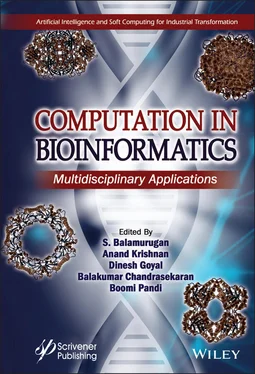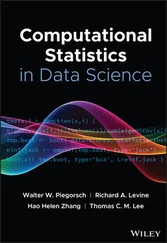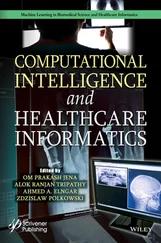Computation in BioInformatics
Здесь есть возможность читать онлайн «Computation in BioInformatics» — ознакомительный отрывок электронной книги совершенно бесплатно, а после прочтения отрывка купить полную версию. В некоторых случаях можно слушать аудио, скачать через торрент в формате fb2 и присутствует краткое содержание. Жанр: unrecognised, на английском языке. Описание произведения, (предисловие) а так же отзывы посетителей доступны на портале библиотеки ЛибКат.
- Название:Computation in BioInformatics
- Автор:
- Жанр:
- Год:неизвестен
- ISBN:нет данных
- Рейтинг книги:4 / 5. Голосов: 1
-
Избранное:Добавить в избранное
- Отзывы:
-
Ваша оценка:
- 80
- 1
- 2
- 3
- 4
- 5
Computation in BioInformatics: краткое содержание, описание и аннотация
Предлагаем к чтению аннотацию, описание, краткое содержание или предисловие (зависит от того, что написал сам автор книги «Computation in BioInformatics»). Если вы не нашли необходимую информацию о книге — напишите в комментариях, мы постараемся отыскать её.
Computation in BioInformatics — читать онлайн ознакомительный отрывок
Ниже представлен текст книги, разбитый по страницам. Система сохранения места последней прочитанной страницы, позволяет с удобством читать онлайн бесплатно книгу «Computation in BioInformatics», без необходимости каждый раз заново искать на чём Вы остановились. Поставьте закладку, и сможете в любой момент перейти на страницу, на которой закончили чтение.
Интервал:
Закладка:
1.2.7 Pharmacophore Modeling
This is a powerful method which can easily categorize a group of molecules/ligands on the basis of active and inactive compounds. They provide set of molecular characteristics that is essential for the macromolecular recognition of ligands triggering a biological reaction. Some of the essential features modeled in pharmacophore are aromatic, hydrophobic, hydrogen bond acceptor (HBA), hydrogen bond donor (HBD), and anion and cation residues. Two main types of Pharmacophore modeling are structure-based modeling and ligand-based modeling.
Structure-based Pharmacophore modeling depends on the 3D structure of the protein obtained from PDB. These structures in PDB are provided by X-ray crystallography technique and/or NMR spectroscopy techniques. In the absence of 3D structure of protein, ligand-based Pharmacophore modeling is performed. Some of the softwares which are used for pharmacophore modeling are HypoGen, HipHop, DISCO, and PHASE.
PHASE: It is a user friendly pharmacophore modeling solution for LBDD and SBDD. It creates hypotheses from protein-ligand complexes and apo proteins with Schrödinger’s unique e-Pharmacophores technology. It can be accessed at https://www.schrodinger.com› phase.
1.2.8 Solubility of Molecule
Once the above steps have been done, the prospective compound is checked for whether the compound is water soluble or readily soluble in lipid which will affect the entry of the cells. The ability of a drug to make entrance into the cell and to bind to the target is an important factor which will determine its potency.
SwissADME: This web tool can analyze drug-likeness and pharmacokinetics of molecules. It evaluates the affability of small molecules in order to compute the physicochemistry of one or several small molecules. It can be easily accessed at http://www.swissadme.ch/index.php.
1.2.9 Molecular Dynamic Simulation
It is a computational method which involves the solution of Newton’s equation for motion to examine the dynamicity of the biological macromolecules. It provides comprehensive information on the fluctuations and conformational changes of proteins and nucleic acids. It helps in understanding the constancy of complexes of protein-ligand or of individual protein. Docking of protein-ligand complex with the ideal binding affinity is usually subjected to MD simulation. The protein topology is initially obtained by standard parameters using GROMACS or LEAP program. Online server PRODRG program is used for generating ligand topology [42]. It allows the study of interactions which occurs between different macromolecules during various cellular life processes and also analyzing of biological processes occurring in a living system. GROMACS is one of the most commonly used MD simulation softwares [43]. It produces trajectory files which carries the information of every conformational change that would have occurred on each atom during simulation. It provides a platform for the researchers to study the stability and minimization of energy of proteins as well as protein bound complexes. Some of software packages like NAMD, GROMACS, CHARMM, and AMBER are used for molecular dynamic simulation [44].
GROMACS: It is one of the most commonly used molecular dynamic simulation softwares. Input files are taken in PDB format which then produces trajectory files that carry the information of each and every conformational changes taking place that would have occurred on each atom during simulation. It requires several commands to process this software. Using this software, researchers are able to study the stability and minimization of energy of proteins as well as protein bound complexes. It can be downloaded from http://www.gromacs.org.
1.2.10 ADME Prediction
It plays an important role in the process of drug discovery. Most drugs with poor pharmacokinetic and toxicity predictions fail in the clinical trials. The toxicity and the molecular property are important properties in a drug whose prediction will help in determining the positivity or negativity of the drug during clinical trials. This method of prediction follows Lipinski’s rule of five [45]. The Lipinski’s rule of five states that HBAs must be less than 10, HBDs must be less than 5, MW of the ligand must not be more than 500 Daltons; the number of rotatable bonds should be less than 10 and the milogP value must be less than five. The Lipinski’s rule accepts compounds with one violation and those satisfying these rules can be orally available for humans. Softwares like PreADMET, VolSurf, admet-SAR, QikProp, PASS, and Molinspiration are used for ADME prediction [46, 47].
MOLINSPIRATION: It provides a wide range of cheminformatic softwares and tools which supports manipulation and processing of molecules. It also includes SD file conversion, SMILES, fragmentation of molecules, creation of tautomers, and calculating molecular properties that are required in QSAR, modeling and designing of drugs, depiction of high quality molecule, and molecular database tools which supports substructure and similarity searches. Molinspiration is user friendly and can be easily accessed at https://www.molinspiration.com/.
1.3 Various Softwares Used in the Steps of Drug Designing
Bioinformatics tools provides information about potential targets that include nucleotide and protein sequencing information, protein and gene expression data, prediction of the function, information of the pathway, mapping information, disease associations, information of the structure, and taxonomic distribution, among others. This helps in reducing time, effort, and money in characterization of different targets. The field of bioinformatics has thus become a major component of the drug discovery pipeline, playing a vital role for validating drug targets. Table 1.4illustrates some of the most commonly used software for drug design, along with their descriptions.
Table 1.4 The list of softwares used in the steps of drug designing is represented in tabular form.
| Sr. no. | Software name | Description |
| 1 | DDDPlus | It helps in dissolution and disintegration study. |
| 2 | GastroPlus | Correlation for various formulations in in vivo and in vitro. |
| 3 | MapCheck | It helps in comparing dose or fluency measurement. |
| 4 | AutoDock | They help in evaluating the ligand-protein interaction. |
| 5 | Schrodinger | They perform ligand-receptor docking. |
| 6 | GOLD | They perform protein-ligand docking. |
| 7 | BioSuite | It performs genome analyzing and sequence analyzing. |
| 8 | Maestro | It involves molecular modeling analysis. |
| 9 | ArgusLab | They perform Molecular docking calculations and provides molecular modeling package. |
| 10 | GRAMM | Protein-protein docking and protein-ligand docking. |
| 11 | SYBYL-X Suite | It involves molecular modeling and ligand-based designing. |
| 12 | Sanjeevini | It can predict protein-ligand binding affinity. |
| 13 | PASS | It can create and analysis of SAR models. |
| 14 | AMIDE (A Medical Image Data Examiner) | They provide medical image analysis in molecular imaging. |
| 15 | Discovery Studio ®Visualizer | It helps in viewing and analyzing protein data. |
| 16 | Imaging Software SCGE-Pro | They perform cytogenetic and DNA damage analysis. |
| 17 | Xenogen Living Image Software | It involves in vivo imaging display and analysis. |
| 18 | GeneSpring | It can identify variation across set of sample and for correction method in samples. |
| 19 | QSARPro | It involves protein-protein interaction study. |
| 20 | REST 2009 Software | They perform analysis of gene expression data. |
| 21 | EthoWatcher | It performs behavior analysis. |
| 22 | MARS (Multimodal Animal Rotation System) | It can perform animal activity tracking, enzyme activity, and nanoparticle tracking and delivery study. |
1.4 Applications
Интервал:
Закладка:
Похожие книги на «Computation in BioInformatics»
Представляем Вашему вниманию похожие книги на «Computation in BioInformatics» списком для выбора. Мы отобрали схожую по названию и смыслу литературу в надежде предоставить читателям больше вариантов отыскать новые, интересные, ещё непрочитанные произведения.
Обсуждение, отзывы о книге «Computation in BioInformatics» и просто собственные мнения читателей. Оставьте ваши комментарии, напишите, что Вы думаете о произведении, его смысле или главных героях. Укажите что конкретно понравилось, а что нет, и почему Вы так считаете.












